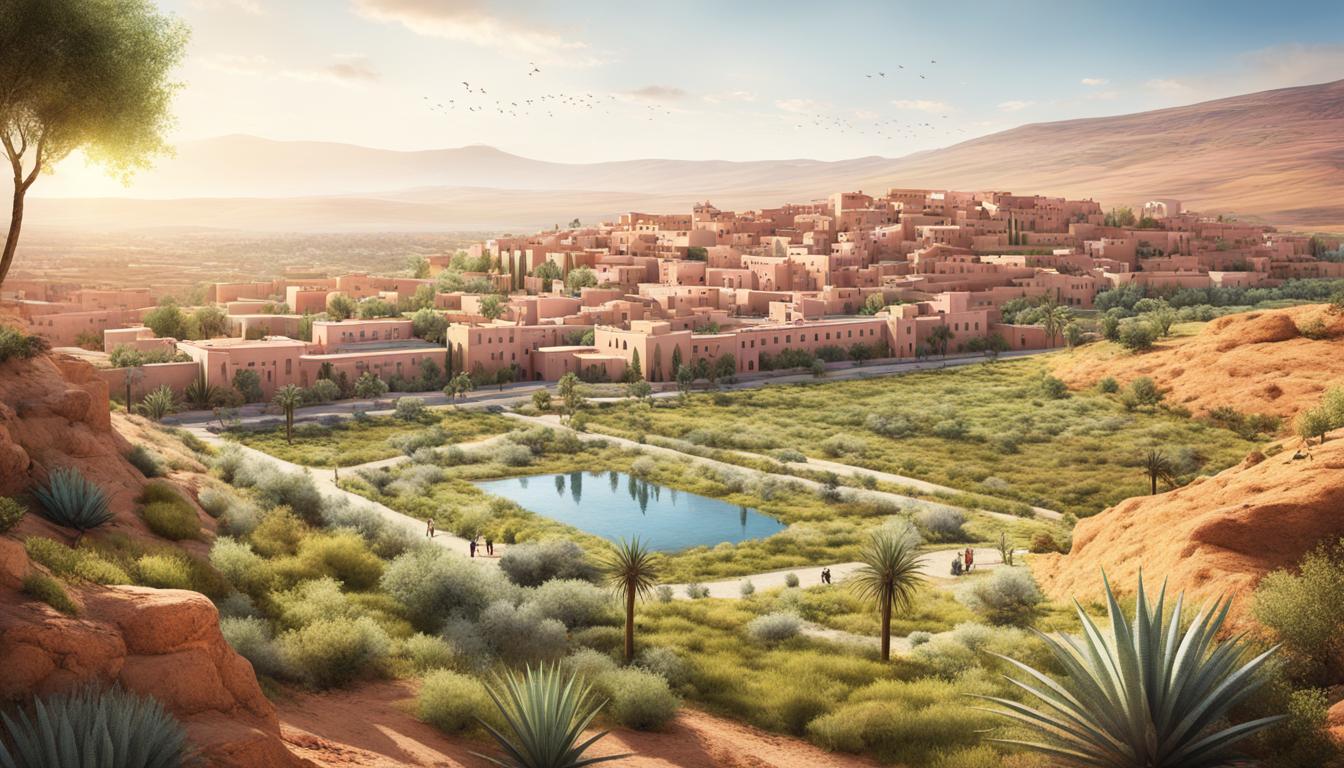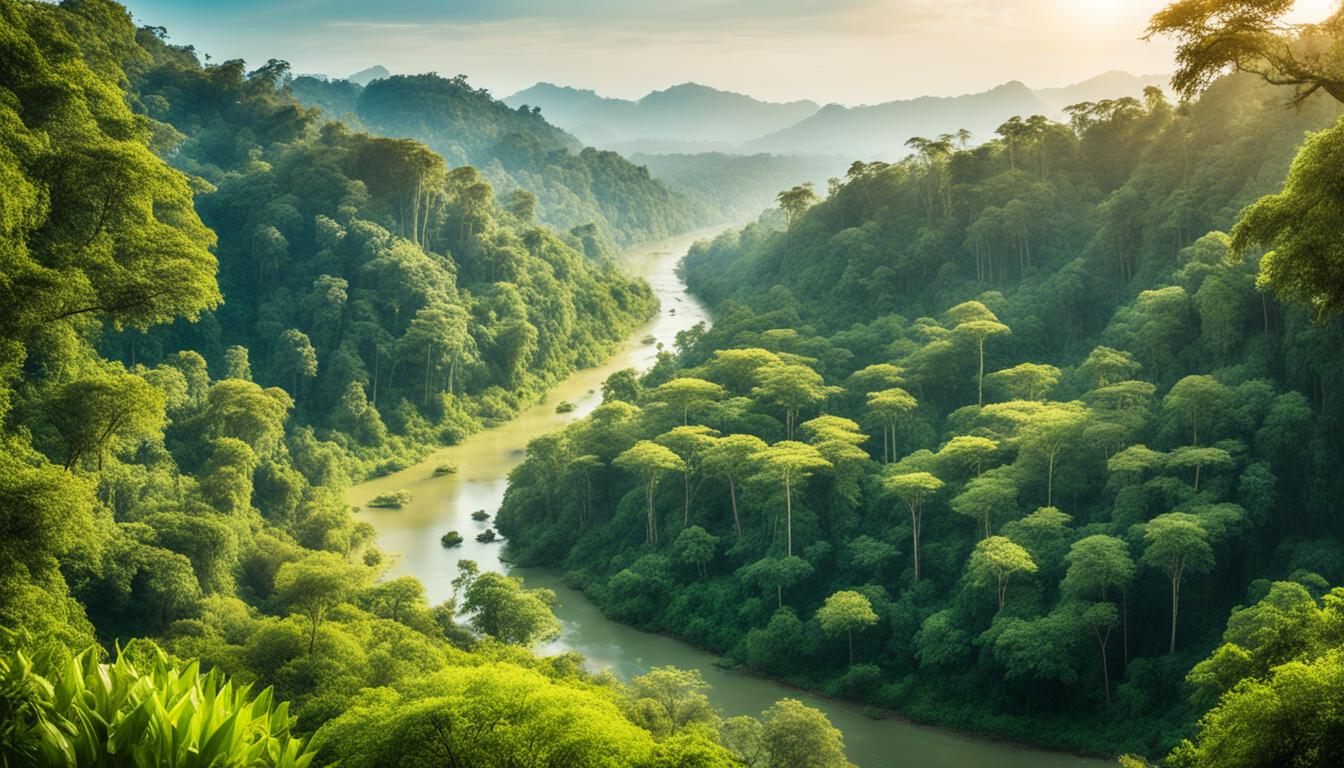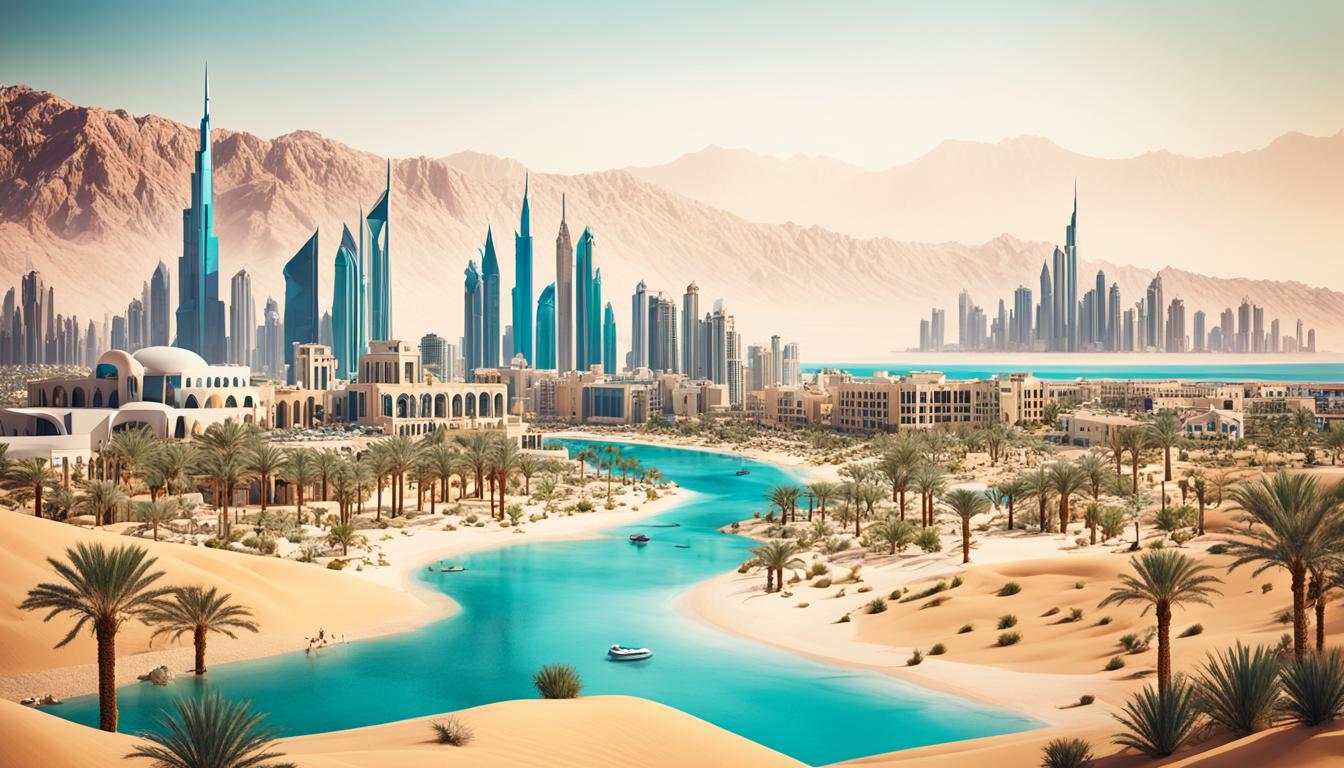Mozambique Biodiversity and the Built Environment
Did you know that Mozambique, a country located in southeastern Africa, has a total land area of 780,000 km2, with 620,000 km2 covered with vegetation? This diverse African nation is not only rich in natural resources but also boasts an incredible array of biodiversity. With over 5,500 plant species, 220 mammals, and 690 birds, Mozambique’s natural heritage is truly remarkable.
Key Takeaways:
- Mozambique has a total land area of 780,000 km2, with 620,000 km2 covered with vegetation.
- The country is home to over 5,500 plant species, 220 mammals, and 690 birds.
- Mozambique faces challenges in balancing economic development with the conservation of its natural resources.
- Understanding the importance of biodiversity is essential for sustainable development and environmental conservation in Mozambique.
- Efforts are being made to protect biodiversity and promote sustainable practices in the built environment through policies and collaborative initiatives.
The Importance of Biodiversity in Mozambique
Biodiversity plays a crucial role in supporting the ecosystem services that sustain human well-being in Mozambique. The country’s rich ecological diversity and wildlife habitat preservation provide essential habitats for a wide range of animal and plant species, contributing to the overall ecological balance.
One of the significant benefits of biodiversity is its potential for green infrastructure development. Green infrastructure refers to strategically planned networks of natural and human-made elements, such as parks, wetlands, and green roofs, that provide numerous environmental benefits. By incorporating green infrastructure into urban areas, Mozambique can enhance its resilience to climate change, improve air and water quality, reduce the urban heat island effect, and create more sustainable and livable cities.
However, the rapid degradation of natural resources and the escalating threats to biodiversity in Mozambique necessitate the implementation of sustainable conservation strategies. Unsustainable land-use practices, deforestation, and pollution are some of the key drivers behind the loss of biodiversity. To address these challenges, it is essential to strike a balance between economic development and the preservation of Mozambique’s natural heritage.
The Role of Ecological Diversity
Ecological diversity, which refers to the variety of ecosystems and habitats within a given geographical area, is critical in maintaining the overall health and resilience of the environment. Each ecosystem provides unique ecosystem services, including clean air and water, soil fertility, climate regulation, and carbon sequestration.
“Ecological diversity is the bedrock of a sustainable future for Mozambique. By preserving and managing diverse ecosystems, we can ensure the long-term well-being of both nature and people.”
Protecting and restoring ecological diversity is essential for sustaining the natural resources that underpin various sectors of Mozambique’s economy, such as agriculture, fisheries, and tourism. Furthermore, preserving diverse ecosystems is crucial for safeguarding native wildlife populations and preventing the extinction of endangered species.
The Significance of Wildlife Habitat Preservation
Wildlife habitat preservation is a key aspect of biodiversity conservation. By safeguarding natural habitats, we can provide essential breeding grounds, foraging areas, and safe spaces for wildlife. Mozambique’s diverse landscapes, from the lush rainforests of the Chimanimani Massif to the coastal mangroves of the Quirimbas Archipelago, support a wide array of animal species.
The preservation of wildlife habitats helps sustain healthy populations of mammals, birds, reptiles, amphibians, and insects. These species perform essential ecological functions such as pollination, seed dispersal, and pest control, which are vital for maintaining the overall health and balance of ecosystems.
Opportunities for Green Infrastructure Development
The growing recognition of green infrastructure in Mozambique presents significant opportunities for sustainable development. By integrating green spaces and natural elements into the urban fabric, Mozambique can enhance environmental quality, improve human well-being, and create more resilient communities.
“Investing in green infrastructure is an investment in our future. By incorporating nature into our cities, we can create healthier, more sustainable, and more livable urban environments.”
Green infrastructure not only helps reduce the impact of climate change but also provides economic benefits. For instance, green roofs and walls can improve building energy efficiency, reducing the need for air conditioning in hot climates. Well-designed parks and green spaces can attract tourism, stimulate economic activity, and enhance the quality of life for residents.
Overall, the importance of biodiversity in Mozambique cannot be overstated. It provides ecological stability, supports vital ecosystem services, and presents invaluable opportunities for sustainable development. Protecting and preserving biodiversity should be a priority for Mozambique, ensuring a harmonious coexistence of nature and human communities for generations to come.
Status of Biodiversity in Mozambique
A comprehensive assessment of Mozambique’s biodiversity and forest resources reveals the remarkable richness and importance of its natural heritage. The country is home to several sites of high biodiversity significance, including the majestic Gorongosa Mountain, the pristine Archipelago of Quirimbas, and the breathtaking Chimanimani Massif.
These biodiverse areas support a wide array of plant and animal species, contributing to the ecological diversity of the region. Mozambique’s forests and protected areas serve as vital habitats for numerous wildlife species, preserving their natural habitats and ensuring their survival.
However, despite the country’s conservation efforts, there are notable challenges that threaten biodiversity in Mozambique. The northern forests of the Niassa Region face the risk of deforestation due to logging activities, which can have devastating impacts on the delicate balance of the ecosystem.
Additionally, the coastal forest ranges are under pressure from agricultural burning practices, leading to the declining forest cover and the loss of vital habitat. These threats demand urgent conservation measures to safeguard Mozambique’s valuable biodiversity and tropical forests for future generations.
“The richness and diversity of Mozambique’s biodiversity are vital components of our natural heritage. Protecting these precious ecosystems is not only essential for preserving the wildlife and plant species but also for maintaining the delicate balance of our environment.” – Environmental Expert
To illustrate the current state of forest cover and land use in Mozambique, the following table provides an overview of the protected areas in the country:
| Protected Area | Area (km2) | Biodiversity Highlights |
|---|---|---|
| Gorongosa National Park | 4,067 | Home to diverse wildlife, including lions, elephants, and buffalo |
| Quirimbas National Park | 7,500 | Preserves pristine coral reefs and supports marine biodiversity |
| Chimanimani National Reserve | 2,060 | Features unique montane forests and rare flora species |
This table highlights the significant contributions of protected areas in conserving Mozambique’s biodiversity and emphasizes the need for their effective management and expansion to ensure the long-term preservation of the country’s natural treasures.

Continued efforts and collaborations between government agencies, organizations, and local communities are essential to protect Mozambique’s biodiversity, promote sustainable land use practices, and ensure the survival of the country’s unique ecosystems.
Threats to Biodiversity in Mozambique
Mozambique’s rich biodiversity faces significant threats, primarily driven by climate change impacts, deforestation, and unsustainable resource use. These challenges pose a grave risk to the country’s unique ecosystems and the species that depend on them.
Climate change has already resulted in noticeable shifts in Mozambique’s weather patterns. The frequency of extreme weather events such as floods, wildfires, landslides, and droughts has increased. These events not only directly impact wildlife and habitats but also have cascading effects on the entire ecosystem.
“More frequent floods, landslides, and other extreme weather events are devastating to the delicate balance of Mozambique’s biodiversity. We need urgent action to mitigate the effects of climate change and protect our natural resources.”
Deforestation is another critical threat to biodiversity in Mozambique. The country’s rich forest cover is rapidly declining due to unsustainable logging practices and the expansion of agricultural activities. Coastal forest ranges are particularly vulnerable to deforestation resulting from slash-and-burn practices.
Unsustainable resource use further exacerbates the threats to biodiversity. Mozambique’s growing population and expanding infrastructure development exert increasing pressure on natural resources. Unsustainable harvesting practices, overfishing, and pollution degrade habitats and diminish the availability of essential resources for wildlife.
The Impact of Climate Change
Climate change in Mozambique has led to rising temperatures, altered rainfall patterns, and increased incidences of extreme weather events. These changes directly affect the availability of suitable habitats for numerous species and disrupt crucial ecological processes.
The rise in temperatures further exacerbates the challenges, as some species may struggle to adapt to the changing conditions. Increased heat stress and reduced water availability can lead to reduced reproductive success, altered migration patterns, and even local extinctions.
“The changing climate poses a severe threat to Mozambique’s unique biodiversity. Urgent steps must be taken to mitigate the impacts and build the resilience of our ecosystems.”
Battling Deforestation and Unsustainable Resource Use
Tackling deforestation requires a comprehensive approach that balances economic development with sustainable land-use practices. It involves implementing stricter regulations, promoting sustainable forestry practices, and raising awareness about the value of intact ecosystems.
Addressing unsustainable resource use involves promoting sustainable fishing practices, reducing pollution, and adopting more efficient and responsible consumption patterns. These efforts aim to preserve the integrity of Mozambique’s ecosystems and ensure the long-term viability of its natural resources.
Preserving Mozambique’s Biodiversity
Mozambique must prioritize the protection and restoration of its biodiversity in the face of these threats. This requires collaborative efforts involving government agencies, non-governmental organizations, local communities, and international partners.
The development and implementation of conservation strategies that take into account the unique ecological characteristics of Mozambique are crucial. These strategies should focus on strengthening protected areas, promoting sustainable agriculture and forestry practices, and mitigating climate change impacts.
By adopting proactive and sustainable measures, Mozambique can safeguard its valuable biodiversity, preserve its natural heritage for future generations, and promote the well-being of both human communities and the environment.
Conservation Efforts and Strategies
To address the conservation challenges, Mozambique has implemented various sustainable development strategies and policies. The country is dedicated to balancing economic growth with environmental preservation, recognizing the importance of incorporating biodiversity conservation into national planning and policies.
“Conservation is not just about protecting wildlife and natural areas; it is about finding innovative ways to harmonize development and conservation for the benefit of both people and nature.” – Mozambique Ministry of Environment and Climate Change
One of the key strategies implemented by Mozambique is the establishment of protected areas. These areas act as sanctuaries for wildlife and play a crucial role in preserving biodiversity. Currently, Mozambique has more than 50 protected areas, including national parks and reserves. These protected areas provide habitat for diverse species and contribute to the country’s urban biodiversity management.
In addition to protected areas, Mozambique has also implemented urban biodiversity management plans. These plans aim to integrate biodiversity conservation into urban planning and development processes. By prioritizing green spaces, promoting sustainable infrastructure, and incorporating nature-based solutions, Mozambique is fostering a harmonious coexistence between urban areas and the natural environment.
Promoting Sustainable Development
Mozambique’s commitment to sustainable development goes beyond protected areas and urban biodiversity management. The country has integrated environmental concerns into its development programs, ensuring that economic growth is achieved in a way that minimizes negative impacts on the environment.
The Mozambican government has implemented various sustainable development strategies, focusing on sectors such as agriculture, energy, and tourism. These strategies aim to promote resource efficiency, renewable energy, and sustainable land-use practices. By adopting sustainable development practices, Mozambique is working towards a more resilient and environmentally conscious future.
Mozambique Environmental Policies
Mozambique has also put in place environmental policies that guide biodiversity conservation and sustainable development efforts. These policies provide a framework for integrating environmental considerations into decision-making processes across sectors.
One notable policy is the Mozambique National Environmental Strategy, which outlines the country’s vision for environmental preservation and sustainable development. This strategy emphasizes the importance of biodiversity conservation and the sustainable use of natural resources. It also promotes the integration of environmental concerns into sectoral policies and programs.
Key Conservation Efforts and Strategies in Mozambique
| Conservation Efforts | Strategies |
|---|---|
| Protected Areas | Establishment of national parks and reserves |
| Urban Biodiversity Management | Integration of biodiversity conservation into urban planning |
| Sustainable Development | Implementation of resource efficiency and sustainable land-use practices |
| Environmental Policies | Integration of environmental concerns into sectoral policies and programs |
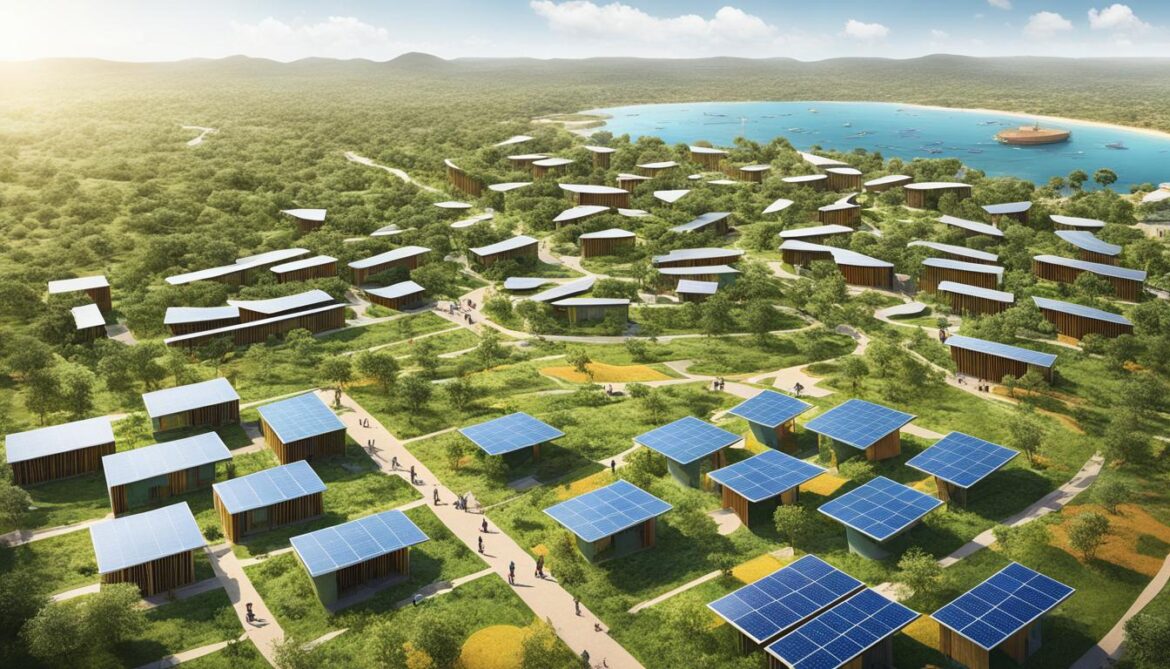
Mozambique’s Green Economy Action Plan
Mozambique is committed to building a sustainable future through its Green Economy Action Plan. This plan recognizes the invaluable role of natural resources in supporting the well-being of both people and biodiversity, while also promoting sustainable development. By integrating environmental considerations into economic decision-making, Mozambique aims to protect its natural capital and foster sustainable urban development.
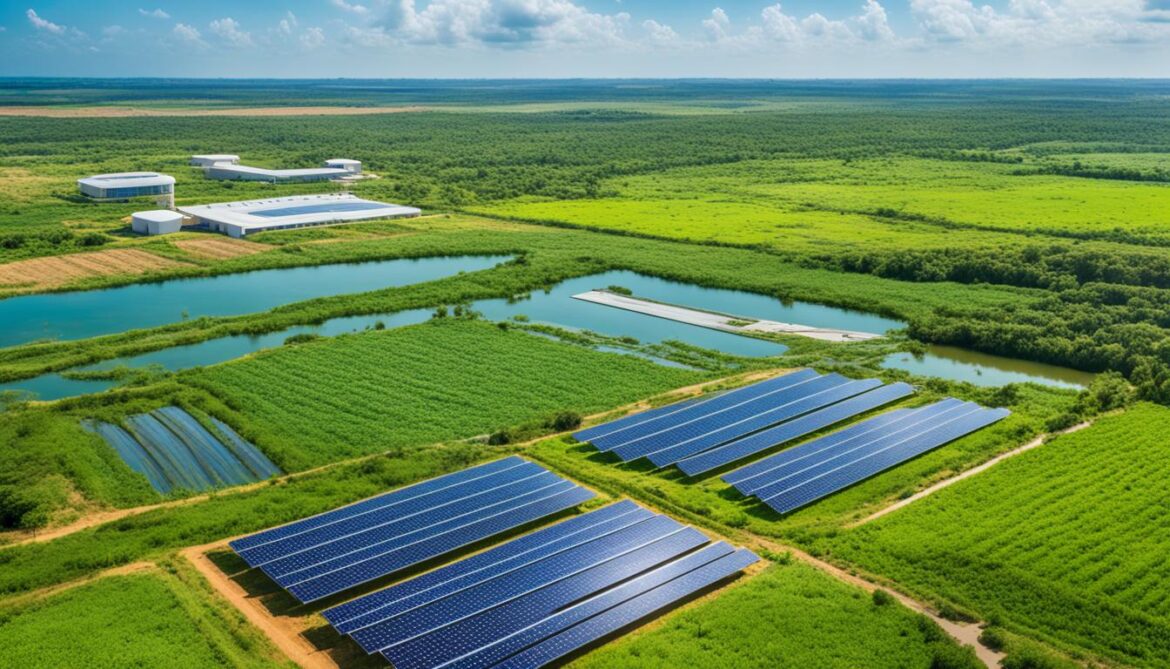
Under the Green Economy Action Plan, Mozambique emphasizes the importance of conserving biodiversity and managing natural resources in a sustainable manner. By preserving its natural capital, which includes ecosystems, forests, water, minerals, and other resources, Mozambique can ensure their availability for current and future generations.
The plan also prioritizes sustainable urban development, recognizing the significance of well-planned cities in achieving environmental, economic, and social goals. By incorporating sustainable practices in urban planning, Mozambique aims to create resilient and livable cities that contribute to the overall well-being of its people.
Promoting a Green Economy
Mozambique’s Green Economy Action Plan seeks to harness the potential of various sectors to drive sustainable development. By promoting green industries, such as renewable energy, sustainable agriculture, and eco-tourism, Mozambique aims to create new opportunities for economic growth while minimizing negative environmental impacts.
Integrating Environmental Considerations
The Green Economy Action Plan recognizes that the pursuit of economic development must go hand in hand with environmental preservation. By integrating environmental considerations into decision-making processes, Mozambique aims to ensure that economic activities are carried out in a sustainable and responsible manner.
“The Green Economy Action Plan is our roadmap to a sustainable future. By protecting our natural capital and promoting sustainable urban development, we can secure a resilient and prosperous Mozambique for generations to come.” – [Name], Minister of Environment and Climate Change
Through this comprehensive plan, Mozambique demonstrates its commitment to achieving a harmonious balance between economic growth, natural resource preservation, and the needs of its people. By embracing a green economy, Mozambique is paving the way for a sustainable and inclusive future.
| Benefits of Mozambique’s Green Economy Action Plan | Key Objectives |
|---|---|
| Preservation of natural capital | Protecting Mozambique’s natural resources and ecosystems |
| Promotion of sustainable urban development | Creating resilient and livable cities |
| Job creation in green industries | Generating employment opportunities in renewable energy, sustainable agriculture, and eco-tourism |
| Minimizing environmental impacts | Integrating environmental considerations into economic decision-making |
| Improved quality of life | Enhancing the well-being of Mozambique’s population through sustainable development |
Building a Sustainable Built Environment in Mozambique
Mozambique is committed to constructing a sustainable built environment that incorporates green infrastructure development and sustainable architecture principles. The country recognizes the importance of promoting energy-efficient buildings, reducing waste and pollution, and enhancing urban resilience in the face of climate change.
One of the key factors in achieving a sustainable built environment is effective urban planning. By prioritizing urban planning that emphasizes biodiversity conservation and ensures a high quality of life for residents, Mozambique can create cities that are both environmentally friendly and socially inclusive.
The Role of Sustainable Architecture
Sustainable architecture plays a pivotal role in the development of a sustainable built environment in Mozambique. By designing and constructing buildings that make efficient use of resources, minimize environmental impact, and prioritize the well-being of occupants, sustainable architecture contributes to the overall sustainability of urban areas.
Through the use of innovative design techniques, sustainable materials, and energy-efficient systems, sustainable architecture in Mozambique aims to create buildings that have a reduced carbon footprint and a positive impact on the environment.
“Sustainable architecture in Mozambique is not just about constructing eco-friendly buildings; it’s about approaching urban development holistically and creating spaces that harmonize with nature.”
Green Infrastructure Development in Mozambique
Green infrastructure development is another crucial aspect of building a sustainable built environment. By incorporating green spaces, such as parks, gardens, and urban forests, into urban areas, Mozambique can enhance biodiversity, improve air quality, and promote physical and mental well-being among residents.
In addition, green infrastructure development in Mozambique includes the integration of sustainable transportation systems, such as walking and cycling paths, and the implementation of water management strategies that reduce the risk of flooding and enhance water conservation.
Urban Planning for Sustainability
Effective urban planning is essential for creating sustainable cities in Mozambique. By considering the principles of biodiversity conservation, energy efficiency, and social equality, urban planning can ensure that cities are designed and developed in a way that minimizes environmental impact and maximizes the well-being of residents.
Urban planning in Mozambique also involves the development of smart and resilient cities that are capable of adapting to the challenges posed by climate change. This includes the implementation of sustainable land-use practices, the integration of renewable energy systems, and the promotion of green building standards.
By prioritizing sustainable architecture, green infrastructure development, and urban planning that takes into account the unique environmental and social context of Mozambique, the country can build a sustainable built environment that benefits both current and future generations.

Mozambique’s National Strategy and Action Plan for Biological Diversity
Mozambique has developed a comprehensive National Strategy and Action Plan for Biological Diversity as part of its conservation initiatives. This plan provides a framework to guide conservation efforts and address the challenges faced by Mozambique’s unique biodiversity.
The National Strategy focuses on promoting biodiversity conservation and ensuring the sustainable use of natural resources. It recognizes the importance of integrating biodiversity considerations into various sectors, including agriculture, fisheries, forestry, and tourism. By mainstreaming biodiversity into these sectors, Mozambique aims to achieve a harmonious balance between development and conservation.
One of the key objectives of the strategy is to secure the long-term conservation of Mozambique’s rich wildlife and habitats. This involves the establishment and management of protected areas, the conservation of key ecosystems, and the enhancement of ecological connectivity.
The National Strategy also emphasizes the need to build capacity and strengthen institutional arrangements for biodiversity conservation. It seeks to enhance scientific research, monitoring, and evaluation to ensure the effective implementation of conservation measures.
Furthermore, the strategy recognizes the crucial role of community involvement in biodiversity conservation. It promotes community-based initiatives that empower local communities to actively participate in the protection and management of natural resources.
“Conserving biodiversity is a shared responsibility that requires collaboration between the government, civil society, and other stakeholders. Our National Strategy and Action Plan provides a roadmap for collective action to safeguard Mozambique’s wealth of biological diversity for future generations.”
In line with its conservation efforts, Mozambique has been actively collaborating with international partners and organizations to exchange knowledge, share best practices, and mobilize resources for biodiversity conservation initiatives.
Mozambique’s National Strategy and Action Plan for Biological Diversity – Key Objectives
| Objective | Description |
|---|---|
| 1. Promote biodiversity conservation | Implement measures to protect and conserve Mozambique’s unique wildlife and habitats. |
| 2. Sustainable use of natural resources | Ensure the responsible and sustainable use of natural resources, considering their long-term viability. |
| 3. Mainstream biodiversity considerations | Integrate biodiversity considerations into various sectors, such as agriculture, fisheries, forestry, and tourism. |
| 4. Establish and manage protected areas | Create and maintain protected areas to preserve critical ecosystems and conserve biodiversity. |
| 5. Enhance scientific research and monitoring | Strengthen research, monitoring, and evaluation efforts to support evidence-based conservation measures. |
| 6. Promote community-based initiatives | Empower local communities to participate in biodiversity conservation and natural resource management. |
By implementing the National Strategy and Action Plan for Biological Diversity, Mozambique is taking significant steps towards protecting its unique biodiversity and promoting sustainable development. This comprehensive plan sets the foundation for a future where the country’s natural heritage thrives alongside economic prosperity.

Promoting Sustainable Development and Conservation Partnerships
Mozambique recognizes the importance of international collaboration and partnerships in achieving sustainable development and biodiversity conservation goals. The country has actively engaged in various environmental partnerships and collaborations with international organizations, non-governmental organizations, and other stakeholders. Through these partnerships, Mozambique aims to share knowledge, resources, and best practices to promote sustainable development and conservation within its borders.
These environmental partnerships in Mozambique provide a platform for stakeholders to collaborate on conservation initiatives, exchange expertise, and develop joint strategies for biodiversity preservation. By working together, these partnerships can harness the collective strengths and resources of diverse stakeholders to address pressing environmental challenges.
“Collaboration is crucial in the field of biodiversity conservation. By sharing our experiences, insights, and resources through partnerships, we can achieve more in protecting Mozambique’s unique natural heritage.” – Statement by Dr. Maria Silva, Director of Mozambique’s National Institute for Biodiversity Conservation
International collaboration plays a pivotal role in supporting Mozambique’s conservation efforts. Through partnerships with international organizations, Mozambique can access funding, technical expertise, and capacity-building opportunities that enhance its ability to conserve biodiversity effectively.
In addition, these partnerships foster knowledge exchange and facilitate the development of innovative conservation strategies tailored to Mozambique’s unique environmental context. By learning from successful initiatives in other countries, Mozambique can identify best practices and adapt them to suit local conditions, maximizing the impact of its conservation efforts.
To illustrate the collaborative nature of Mozambique’s sustainable development and biodiversity conservation, the following table highlights some key environmental partnerships:
| Partnership | Description |
|---|---|
| Conservation International | A global organization working to protect nature and biodiversity through science, policy, and partnerships. Collaborating with Mozambique to develop sustainable land-use practices and support community-based conservation initiatives. |
| United Nations Development Programme (UNDP) | Working with Mozambique to integrate biodiversity conservation into national development plans and strengthen institutional capacity for sustainable development. |
| World Wildlife Fund (WWF) | Partnering with Mozambique to conserve marine biodiversity and support sustainable fisheries management along the country’s coastline. |
| Community-Based Natural Resources Management Network (CBNRM) | A network of local communities, NGOs, and government agencies collaborating to implement community-led conservation programs and sustainable resource management initiatives. |
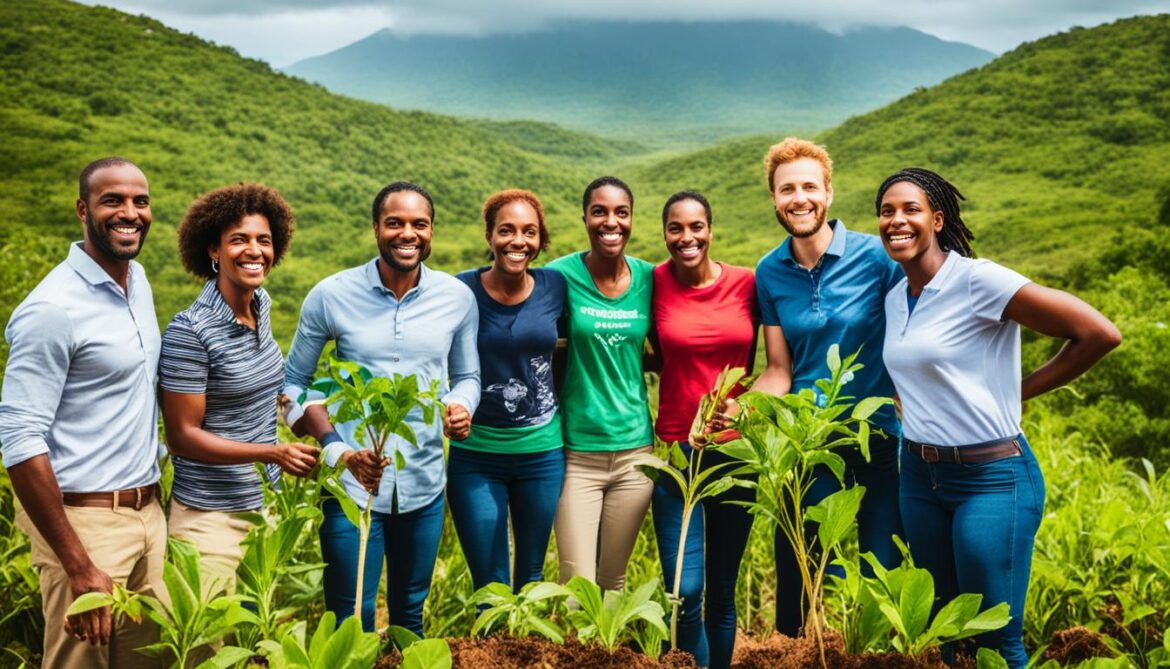
These partnerships exemplify the collaborative and inclusive approach to conservation that Mozambique embraces. By leveraging the diverse expertise, resources, and perspectives of its partners, Mozambique can foster sustainable development, preserve its rich biodiversity, and ensure a thriving natural environment for future generations.
The Role of Communities and Stakeholders
Community involvement and stakeholder engagement are crucial for the successful conservation of biodiversity in Mozambique. Through community-based conservation initiatives, local communities are empowered to protect and manage natural resources sustainably, ensuring the long-term preservation of the country’s unique ecosystems.
Engaging stakeholders, including government agencies, civil society organizations, and private sector entities, is essential in biodiversity conservation efforts. By collaborating with diverse stakeholders, Mozambique can adopt a holistic and inclusive approach to environmental protection, leveraging a wide range of expertise, resources, and perspectives.
Community-Based Conservation Mozambique
Community-based conservation strategies are at the forefront of efforts to protect Mozambique’s biodiversity. These initiatives involve active participation and leadership of local communities, who possess invaluable traditional knowledge and a deep connection to the land. By involving communities in the decision-making and management processes, these conservation efforts promote a sense of ownership and responsibility.
Community-based conservation initiatives in Mozambique often include:
- Establishing community-led conservation areas
- Supporting sustainable livelihoods that reduce dependence on natural resources
- Providing training and capacity-building opportunities for local communities
- Encouraging sustainable tourism practices that generate income and create awareness about the value of biodiversity
Stakeholder Engagement in Biodiversity Conservation
Effective stakeholder engagement is key to the success of biodiversity conservation efforts in Mozambique. By involving various stakeholders, the country can benefit from their expertise, financial resources, and influence to make informed decisions and implement sustainable practices.
Engaging stakeholders in biodiversity conservation can take various forms:
- Collaboration with government agencies to develop and enforce environmental policies
- Partnerships with civil society organizations to raise awareness, conduct research, and implement conservation projects
- Engagement with private sector entities to incorporate environmental considerations into their operations and support conservation initiatives
By fostering collaboration and dialogue among stakeholders, Mozambique can establish a shared vision for biodiversity conservation and work towards its realization.
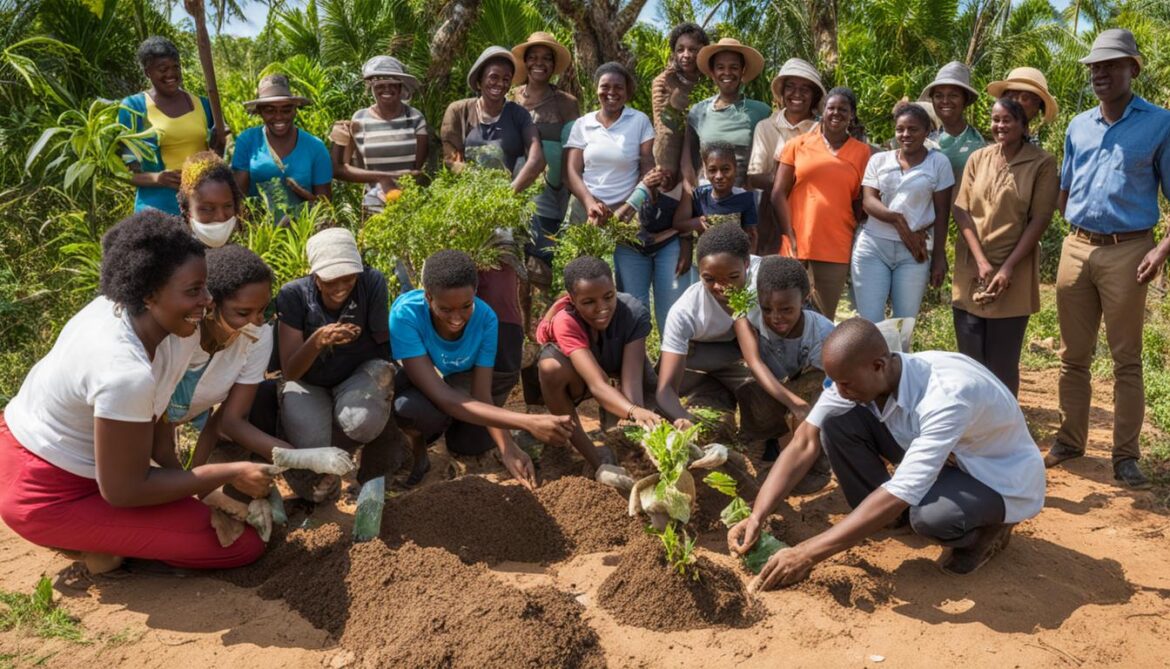
| Benefits of Community-Based Conservation | Benefits of Stakeholder Engagement |
|---|---|
|
|
The Future of Biodiversity in Mozambique
The future of biodiversity in Mozambique relies heavily on the implementation of effective conservation strategies and sustainable development practices. To ensure the preservation of its rich natural heritage, Mozambique must continue strengthening its environmental policies and invest in innovative conservation approaches. By prioritizing biodiversity conservation and sustainable land-use practices, the country can pave the way for a resilient and prosperous future for both human communities and the natural environment.
One of the key biodiversity conservation strategies for Mozambique is the establishment and management of protected areas. These areas serve as important habitats for a diverse range of plant and animal species and play a crucial role in maintaining ecological balance. By expanding the network of protected areas and ensuring their effective management, Mozambique can safeguard vital wildlife habitats and contribute to the long-term preservation of biodiversity.
Conservation is not just about protecting individual species or habitats; it is about safeguarding the intricate web of life that sustains us all. By protecting Mozambique’s biodiversity, we are investing in the future of our planet and securing the well-being of future generations.
Another crucial aspect of biodiversity conservation in Mozambique is sustainable development. The country needs to strike a balance between economic growth and environmental sustainability by adopting sustainable land-use practices. This involves promoting resource-efficient agricultural methods, implementing responsible forestry practices, and encouraging the adoption of renewable energy sources. By integrating sustainable development principles into its economic plans and policies, Mozambique can achieve a harmonious coexistence between human activities and nature.
Investing in Education and Awareness
Education and awareness play a pivotal role in biodiversity conservation. Mozambique can promote a culture of environmental stewardship by incorporating biodiversity conservation into the national curriculum and conducting awareness campaigns at the community level. By enhancing public understanding of the value of biodiversity and the benefits it provides, Mozambique can cultivate a sense of responsibility towards nature and encourage active participation in conservation efforts.
Collaboration and Partnerships
Mozambique can also leverage collaboration and partnerships to enhance its biodiversity conservation efforts. Engaging with international organizations, NGOs, local communities, and other stakeholders can foster knowledge exchange, resource sharing, and the implementation of best practices. By working together towards a common goal, Mozambique can amplify its impact and achieve more significant outcomes in preserving its extraordinary biodiversity.
In conclusion, the future of biodiversity in Mozambique hinges on the adoption of effective conservation strategies and sustainable development practices. By integrating biodiversity conservation into national plans, expanding protected areas, promoting sustainable land-use practices, investing in education and awareness, and fostering collaboration, Mozambique can create a sustainable and biodiverse future for generations to come.
Conclusion
Mozambique’s rich biodiversity and its built environment are closely intertwined, playing a vital role in sustainable development. By prioritising biodiversity conservation, implementing green infrastructure and sustainable architecture principles, and fostering engagement with stakeholders, Mozambique can strike a harmonious balance between economic advancement, urban development, and environmental preservation. Such commitment to sustainability is the key to creating a resilient and prosperous future.
Preserving Mozambique’s biodiversity is of utmost importance to ensure the well-being of both its diverse wildlife and local communities. By protecting and sustaining the country’s natural resources, Mozambique can safeguard wildlife habitats, promote ecological diversity, and mitigate the impacts of climate change. Additionally, integrating green infrastructure and sustainable practices into urban development strategies not only enhances the quality of life for residents but also creates opportunities for sustainable economic growth.
The implementation of effective conservation strategies and the integration of sustainability into national policies are crucial for Mozambique’s future. By fostering partnerships and collaborations with international organizations, non-governmental parties, and local communities, Mozambique can tap into a wealth of knowledge, resources, and best practices for biodiversity conservation. It is through these collective efforts that Mozambique can successfully achieve its goals of preserving its unique biodiversity, promoting sustainable development, and securing a bright future for generations to come.
FAQ
What is the importance of biodiversity in Mozambique?
Biodiversity plays a crucial role in providing habitat for wildlife species, contributing to ecological diversity, and offering opportunities for green infrastructure development in Mozambique.
What is the current status of biodiversity in Mozambique?
Mozambique is rich in biodiversity, with diverse plant and animal species. However, there are challenges in preserving this biodiversity due to factors such as deforestation and unsustainable resource use.
What are the threats to biodiversity in Mozambique?
Mozambique faces threats to its biodiversity from climate change impacts, deforestation, and unsustainable resource use. These factors contribute to the degradation of natural resources and pose risks to biodiversity conservation.
What conservation efforts and strategies are being implemented in Mozambique?
Mozambique has implemented sustainable development strategies, established protected areas, and integrated environmental concerns into its development programs to address the conservation challenges. Urban biodiversity management plans have also been implemented.
What is Mozambique’s Green Economy Action Plan?
Mozambique’s Green Economy Action Plan aims to protect the country’s natural capital and promote sustainable urban development. It emphasizes the conservation of biodiversity, sustainable use of natural resources, and integration of environmental considerations into economic decision-making.
How is Mozambique building a sustainable built environment?
Mozambique is incorporating green infrastructure development and sustainable architecture principles to create a sustainable built environment. This includes promoting energy-efficient buildings, reducing waste and pollution, and enhancing urban resilience to climate change.
What is Mozambique’s National Strategy and Action Plan for Biological Diversity?
Mozambique’s National Strategy and Action Plan for Biological Diversity guides conservation efforts and addresses challenges facing biodiversity. It focuses on promoting biodiversity conservation, sustainable use of natural resources, and mainstreaming biodiversity considerations into various sectors.
How is Mozambique promoting sustainable development and conservation partnerships?
Mozambique recognizes the importance of international collaboration and partnerships. The country has engaged in partnerships with international organizations and stakeholders to share knowledge, resources, and best practices for promoting sustainable development and conservation.
What is the role of communities and stakeholders in biodiversity conservation in Mozambique?
Community-based conservation initiatives empower local communities to protect and manage natural resources sustainably. Engaging stakeholders, including government agencies, civil society organizations, and the private sector, ensures a holistic and inclusive approach to biodiversity conservation.
What does the future of biodiversity in Mozambique depend on?
The future of biodiversity in Mozambique depends on the implementation of effective conservation strategies, sustainable development practices, and the promotion of sustainable land-use practices. Prioritizing biodiversity conservation and sustainable development will pave the way for a resilient and thriving future.



